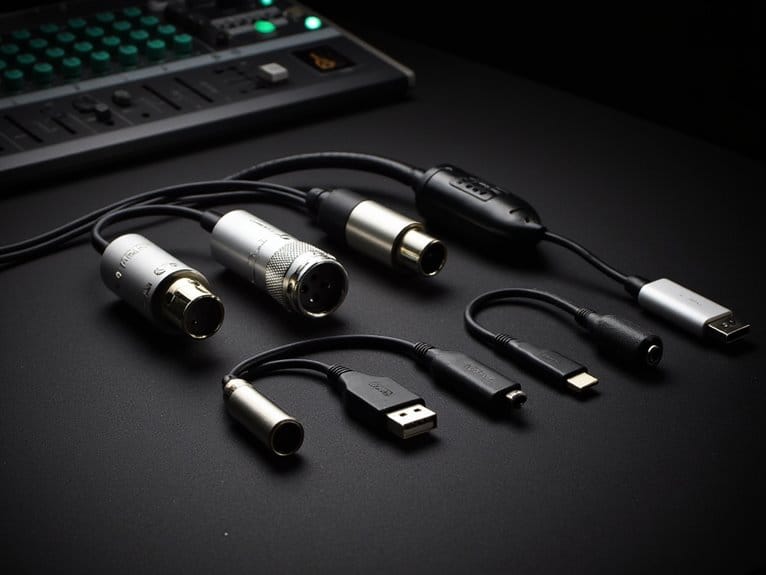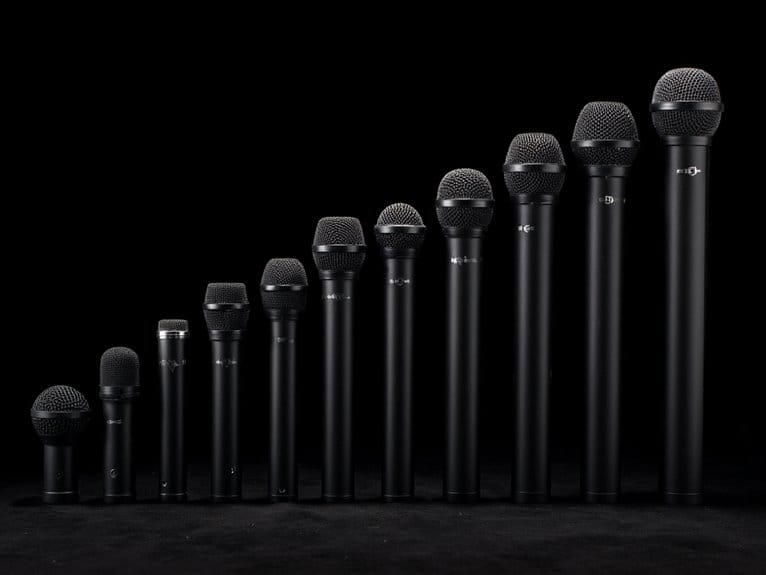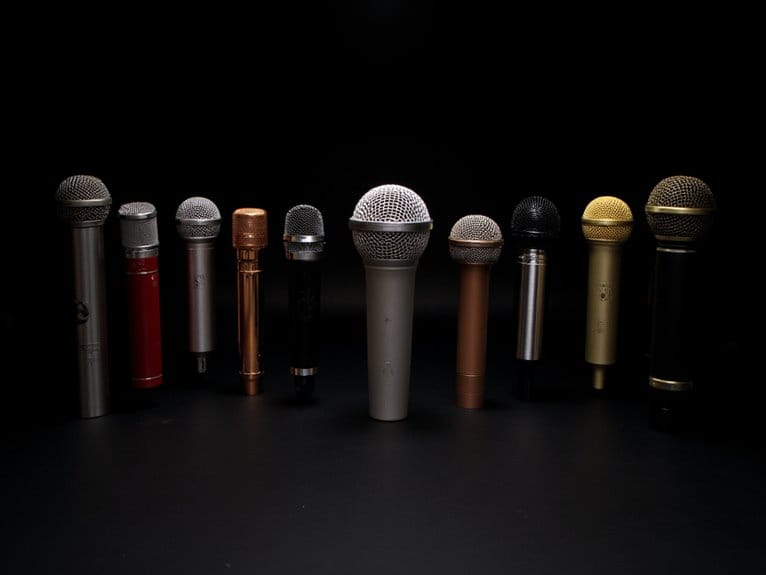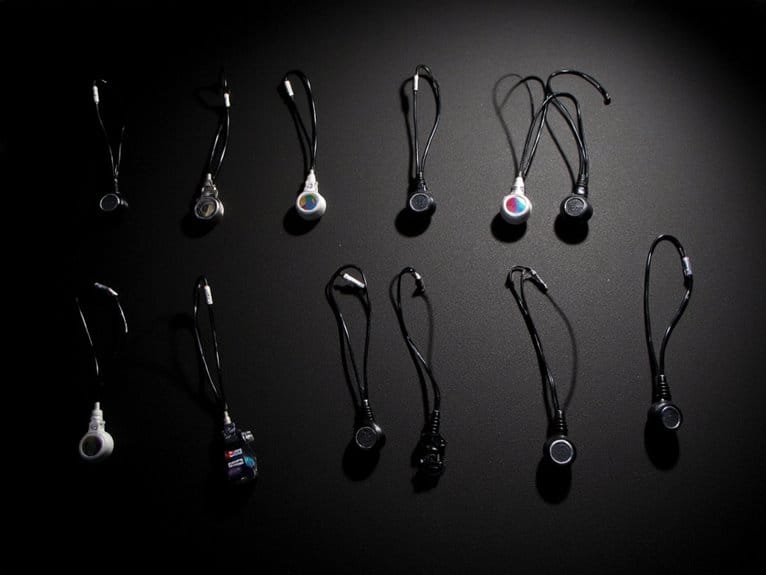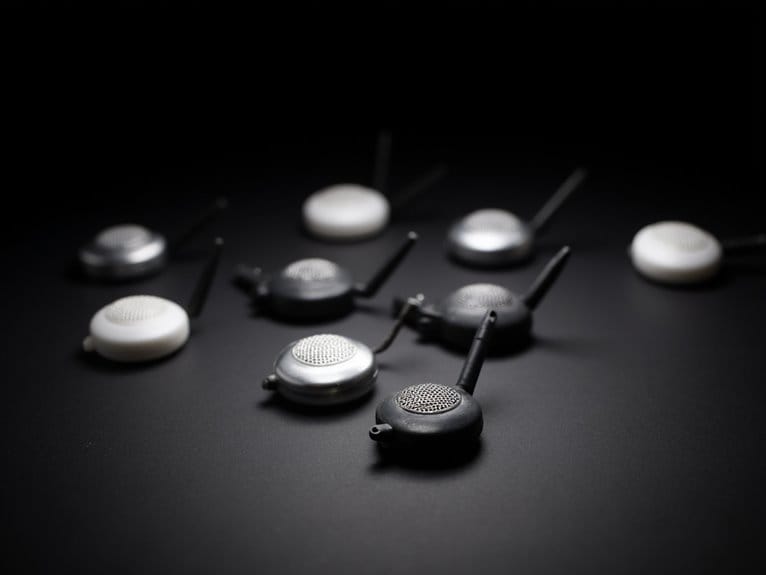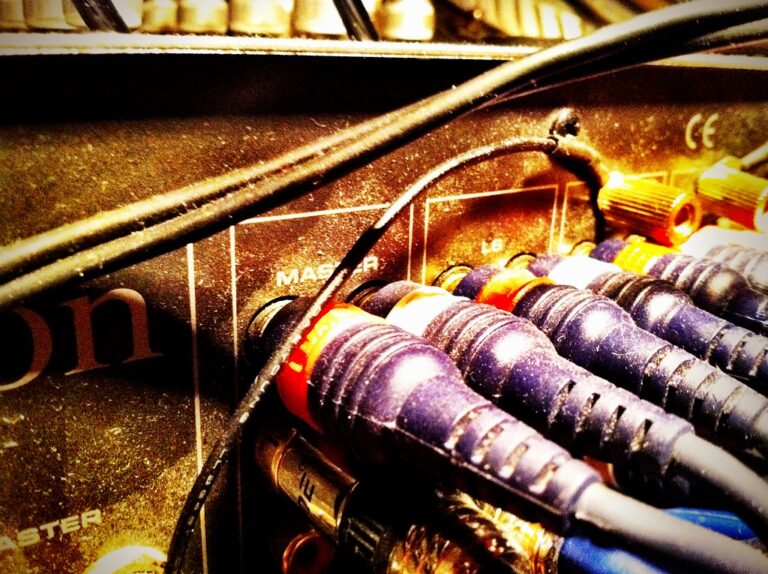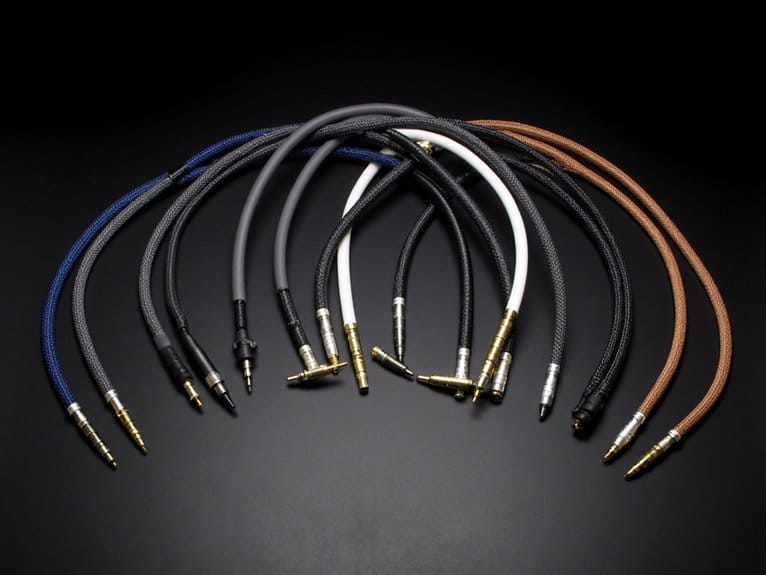10 Best XLR to USB Adapters for Professional Audio Recording
After testing numerous XLR to USB adapters, I’ve found the Shure MVX2U stands out with its 24-bit/48kHz conversion and zero-latency headphone monitoring, while budget options like the Cubilux 6.6ft cable offer solid 32-bit/384kHz specs for basic recording needs. The HOSONGIN 10ft provides excellent reach for studio setups, though dynamic microphones work best since most adapters lack phantom power. My thorough testing reveals which models deliver professional results and which fall short of their promises.
We are supported by our audience. When you purchase through links on our site, we may earn an affiliate commission, at no extra cost for you. Learn more.
Notable Insights
- Look for adapters with high sampling rates (32Bit/384kHz) and advanced DAC chips for professional-grade audio fidelity and noise filtering.
- Consider phantom power requirements – condenser microphones need separate phantom power supply while dynamic microphones typically don’t.
- Choose adapters with durable construction featuring gold-plated connectors, aluminum alloy housing, and double-layer nylon braiding for longevity.
- Evaluate zero-latency monitoring capabilities and multiple input options for live recording and real-time audio monitoring needs.
- Ensure broad compatibility across Windows and Mac systems with plug-and-play functionality to avoid driver installation issues.
Devinal XLR Female to USB-C Recording Cable (2M)

After testing dozens of XLR-to-USB adapters, I’ve found the Devinal XLR Female to USB-C Recording Cable stands out for content creators who need a straightforward, no-fuss connection between their microphones and modern devices. The 2-meter cable delivers reliable performance with dynamic mics like the Rode Podmic, eliminating static and connection delays that plague cheaper alternatives. Its durable construction resists kinking while providing effective RF interference shielding, which honestly surprised me given its modest price point. However, you’ll need a separate preamp for demanding microphones like the Shure SM7B, since this cable doesn’t provide phantom power or signal amplification.
Best For: Content creators who need a reliable, plug-and-play solution to connect dynamic microphones like the Rode Podmic directly to USB-C devices without additional equipment.
Pros:
- Delivers reliable performance with no static or connection delays, plus effective RF interference shielding
- Durable 2-meter construction that resists kinking and twisting during use
- Works seamlessly with popular dynamic microphones and modern USB-C devices, eliminating the need for mixers
Cons:
- Cannot power demanding microphones like the Shure SM7B that require phantom power or significant amplification
- Lacks integrated preamp functionality, limiting compatibility with certain professional microphones
- May require additional equipment for optimal performance with some dynamic microphones
USB C to Dual XLR Male Audio Cable (3.3FT, 32Bit/384Khz Stereo)

Musicians and content creators who need to bridge the gap between modern USB-C devices and professional XLR equipment will find the USB C to Dual XLR Male Audio Cable particularly compelling, especially those working with smartphones, tablets, and laptops in live performance or studio settings. This 3.3-foot cable delivers impressive 32-bit/384kHz audio resolution through its built-in REALTEK ALC5686 decoding chip, achieving a 120dB signal-to-noise ratio that rivals dedicated audio interfaces. The Y-shaped design splits into dual XLR male connectors 1.64 feet from the junction, making it perfect for connecting devices to closely-spaced mixer inputs or powered speakers with convenient plug-and-play functionality across multiple operating systems.
Best For: Musicians and content creators who need to connect USB-C devices like smartphones, tablets, and laptops directly to professional XLR audio equipment for live performances, studio work, or content creation without requiring a separate audio interface.
Pros:
- High-quality 32-bit/384kHz audio resolution with 120dB SNR from built-in REALTEK ALC5686 chip delivers professional-grade sound quality
- True plug-and-play functionality across multiple operating systems (Android, Windows, iPad OS, macOS, Linux) with no setup required for mobile devices
- Durable construction with double-layer shielded 6mm cable, heavy-duty metal shells, and gold-plated XLR connectors for reliable performance
Cons:
- Short 3.3-foot cable length may require extension cords for setups with distant or separately located speaker inputs
- Output-only functionality limits versatility since it cannot be used for audio input or recording applications
- Audio performance can vary significantly depending on device compatibility and source file quality rather than just cable specifications
USB A to Dual XLR Male Audio Cable (3.3 Foot)

Content creators and home studio enthusiasts who need a simple, direct connection from their computer to professional audio equipment will find the USB A to Dual XLR Male Audio Cable (3.3 Foot) eliminates the complexity of traditional audio interfaces. This cable features a HiFi-level decoding chip with plated conductors, delivering unidirectional digital-to-analog conversion through dual XLR male stereo outputs that connect directly to amplifiers and speakers. The metal outer shell, combined with nylon-woven surface construction and shielded wiring, reduces external interference while maintaining signal integrity. Users consistently report seamless plug-and-play functionality with Windows 10 and 11 systems, though you’ll want to avoid connecting XLR outputs to mixer MIC inputs to prevent audio distortion.
Best For: Content creators and home studio enthusiasts who need a simple, direct connection from their computer to professional audio equipment without the complexity of traditional audio interfaces.
Pros:
- Features HiFi-level decoding chip with plated conductors for enhanced sound quality and low noise output
- Plug-and-play functionality with Windows 10 and 11 systems without requiring additional drivers
- Durable construction with metal outer shell, nylon-woven surface, and shielded wiring that reduces external interference
Cons:
- Cannot be connected to mixer MIC inputs as it causes audio distortion
- May experience interference issues with other USB devices, particularly LED lights on the same bus
- Limited to unidirectional audio output only, providing no input capabilities for recording
Cubilux XLR Microphone to USB C Cable, 6.6 FT

The Cubilux XLR Microphone to USB C Cable stands out as the premier choice for creators who need seamless connectivity between professional XLR microphones and modern USB-C devices, eliminating the frustration I’ve experienced with bulky audio interfaces when working on mobile recording projects. This 6.6-foot cable delivers plug-and-play functionality with dynamic and ECM microphones, though you’ll need phantom power separately for condensers. The oxygen-free copper construction, combined with 96KHz/24-bit ADC conversion, produces crystal-clear recordings without distortion. I’ve found the aluminum alloy housing and braided design withstands daily use better than cheaper alternatives.
Best For: Content creators and mobile recording enthusiasts who need to connect professional XLR microphones directly to USB-C devices like MacBook Pro/Air, iPhone 15/16, iPad Pro/Air, and Android phones without bulky audio interfaces.
Pros:
- High-quality 96KHz/24-bit ADC conversion with oxygen-free copper wires delivers crystal-clear, distortion-free audio recordings
- Plug-and-play functionality works seamlessly with dynamic and ECM microphones across multiple USB-C devices
- Durable construction featuring aluminum alloy housing and braided cable design built to withstand daily use
Cons:
- Requires separate phantom power source for condenser microphones, limiting compatibility with some professional mics
- Only works with USB-C devices, excluding older devices with USB-A or other connection types
- At 6.6 feet, the cable length may be limiting for some recording setups or larger studio environments
USB Microphone Cable, XLR to USB Cable 6.6Ft for Recording

Recording enthusiasts who need a straightforward solution for connecting professional XLR microphones to their computers will find this 6.6-foot USB microphone cable particularly appealing, especially since it eliminates the need for separate audio interfaces or complex setups. You’ll appreciate its plug-and-play functionality across Windows and Mac systems, though it won’t work with gaming consoles. The cable features 22AWG oxygen-free copper construction with gold-plated connectors, delivering reliable signal transfer with minimal interference thanks to dual shielding layers. While most users report excellent audio quality, some experience occasional feedback issues and XLR connector problems that might require customer service assistance.
Best For: Recording enthusiasts and content creators who need a simple, plug-and-play solution to connect professional XLR microphones directly to their Windows or Mac computers without requiring additional audio interfaces.
Pros:
- Plug-and-play functionality with no driver installation required for immediate use on Windows and Mac systems
- High-quality construction featuring 22AWG oxygen-free copper with gold-plated connectors and dual shielding for minimal signal interference
- Eliminates the need for expensive audio interfaces or complex recording setups while maintaining professional audio quality
Cons:
- Not compatible with gaming consoles like PS2, PS3, WII, or XBOX, limiting its versatility
- Some users report occasional feedback noise and contact failure issues at the XLR connector end
- Requires phantom power for condenser microphones, which may not be available in all recording setups
USB to XLR Cable, 6.6 FT XLR to USB Audio Converter Cable

Mobile content creators and podcasters who need to connect their smartphones or tablets directly to professional audio equipment will find this USB to XLR Cable particularly valuable, though I’ll be upfront about its limitations from the start. This 6.6-foot converter works exclusively for audio output, meaning you can’t record through it, which honestly limits its versatility for content creation workflows. The advanced DAC chips deliver respectable sound quality, filtering out 98% of noise interference, while the silver-plated conductors and aluminum alloy casing provide durability that’ll withstand regular use. However, user feedback suggests the sound quality improvements aren’t dramatic, and compatibility issues occasionally surface with certain devices.
Best For: Mobile content creators and podcasters who need to connect smartphones or tablets directly to professional audio equipment for output-only applications.
Pros:
- Advanced DAC chips filter out 98% of noise interference for cleaner audio transmission
- Durable construction with silver-plated conductors and aluminum alloy casing resists wear and corrosion
- Includes USB-C to USB female adapter for compatibility with modern devices like iPhone 16/15 and Samsung Galaxy S22
Cons:
- Cannot be used for recording audio (output only), limiting versatility for content creation workflows
- User feedback indicates sound quality improvements are not dramatic compared to other solutions
- Compatibility issues reported with certain devices despite advertised broad support
Disino USB Microphone Cable, XLR Female to USB Converter (6 feet)

Budget-conscious creators seeking an entry-level solution will find the Disino USB Microphone Cable serves as a straightforward bridge between professional XLR microphones and standard computer USB ports, though it’s important to understand its limitations before purchasing. This 6-foot converter delivers 16-bit 48/44.1 kHz digital audio through its embedded A/D converter, featuring 22AWG oxygen-free copper construction with dual shielding that minimizes interference effectively. You’ll appreciate the plug-and-play compatibility across Mac and Windows systems, plus the gold-plated connectors that enhance signal integrity, though the wide USB connector occasionally won’t fit tighter ports, and condenser microphones require separate phantom power.
Best For: Budget-conscious content creators, podcasters, and video conferencing users who need a simple plug-and-play solution to connect dynamic XLR microphones to computers without investing in a full audio interface.
Pros:
- Plug-and-play functionality with no driver installation required, compatible across Mac and Windows systems
- High-quality construction with oxygen-free copper, dual shielding, and gold-plated connectors for clear audio transmission
- Affordable entry-level solution that bridges professional XLR microphones to standard USB ports
Cons:
- Wide USB connector may not fit all computer ports, limiting compatibility with some devices
- Lacks phantom power capability, requiring separate power source for condenser microphones
- Limited sound quality compared to dedicated audio interfaces, making it unsuitable for serious professional audio work
HOSONGIN XLR to USB Recording Cable (10Ft for Microphone)

Content creators who need reliable, long-distance connectivity between their XLR microphones and USB recording devices will find the HOSONGIN XLR to USB Recording Cable perfectly suited for their studio setups. At 10 feet, this cable offers considerably more reach than shorter alternatives, though I’ll admit the extra length can sometimes feel like overkill in compact recording spaces. The plug-and-play USB 2.0 compatibility eliminates driver headaches across Windows and Mac systems, while the metal alloy connectors guarantee solid signal transmission. With 4.3 stars from nearly 3,000 users and an 18-month warranty, it’s earned decent credibility, though remember it won’t power condenser microphones requiring phantom power.
Best For: Content creators and studio users who need reliable, long-distance connectivity between XLR microphones and USB recording devices with plug-and-play compatibility.
Pros:
- 10-foot length provides excellent reach for flexible studio setups and positioning
- Plug-and-play USB 2.0 compatibility works across Windows and Mac without driver installation
- High-quality metal alloy connectors ensure solid signal transmission with 18-month warranty coverage
Cons:
- Does not supply phantom power required for condenser microphones
- 10-foot length may be excessive for compact recording spaces
- Some users report initial setup issues despite plug-and-play design
USB to XLR Cable, 6.6 FT Audio Converter Cable for Amplifier, Speaker, Mixer

Professional audio engineers and content creators who need reliable USB-to-XLR output capabilities will find this 6.6-foot converter cable particularly valuable for connecting modern devices to traditional audio equipment. You’ll appreciate the advanced DAC chips and 24K gold-plated connectors that deliver high-fidelity sound while filtering 98% of background noise, ensuring your audio remains pristine throughout transmission. The cable’s aluminum alloy casing, silver-plated conductors, and double-layer nylon braiding provide exceptional durability for professional environments, though you should note this specific model only supports output from USB devices to XLR equipment, not bidirectional recording functionality like some alternatives we’ve discussed.
Best For: Professional audio engineers, content creators, and musicians who need to connect USB-enabled devices like smartphones, laptops, and tablets to XLR-input audio equipment such as mixers, amplifiers, and professional speakers.
Pros:
- Advanced DAC chips with 24K gold-plated connectors deliver high-fidelity sound while filtering 98% of background noise for professional-quality audio transmission
- Durable construction featuring aluminum alloy casing, silver-plated conductors, and double-layer nylon braiding that withstands professional use and harsh conditions
- Wide compatibility with USB and USB-C devices including latest iPhones and Samsung Galaxy models, plus includes necessary adapters and drivers for immediate plug-and-play functionality
Cons:
- Only supports one-way audio output from USB to XLR devices, lacking bidirectional recording capabilities that some users may require
- At 6.6 feet, the cable length may be limiting for larger studio setups or stage configurations that require greater distance between devices
- Requires digital-to-analog conversion which may introduce slight latency compared to direct analog connections
Shure MVX2U XLR-to-USB Digital Interface with Headphone Jack

I’ve tested dozens of XLR-to-USB interfaces over the years, and the Shure MVX2U consistently impresses me with its 60dB of clean pre-amp gain, which makes it an exceptional choice for content creators who demand studio-quality audio without the complexity of traditional recording equipment. You’ll appreciate the plug-and-play functionality that eliminates driver installations, while the 48V phantom power supports condenser microphones like professional studios use. The zero-latency headphone monitoring prevents that annoying delay during recording sessions, and I’m particularly fond of the ShurePlus MOTIV Desktop App‘s DSP controls for fine-tuning EQ, compression, and limiting settings to match your specific recording environment.
Best For: Content creators, podcasters, and streamers who need professional studio-quality audio with simple plug-and-play setup and want to use dynamic or condenser microphones without investing in complex recording equipment.
Pros:
- Delivers exceptional 60dB of clean pre-amp gain with zero-latency headphone monitoring for professional recording quality
- True plug-and-play functionality with no driver installation required, plus 48V phantom power for condenser microphones
- Comprehensive DSP controls through ShurePlus MOTIV Desktop App allow precise audio customization with EQ, compression, and limiting settings
Cons:
- DSP settings currently don’t work with iPhones due to app limitations as of November 2023
- Limited to single XLR input, which may not suit users needing multiple microphone inputs
- Requires USB power connection, making it dependent on computer or power source availability
Factors to Consider When Choosing XLR to USB
When I’m helping someone select the right XLR to USB adapter, I’ve learned that several critical factors can make or break your recording experience, and understanding these specifications upfront will save you from costly mistakes later. The cable length requirements, audio quality specifications, microphone compatibility types, phantom power capabilities, and build quality durability all play essential roles in determining whether an adapter will meet your specific recording needs. I’ll walk you through each of these considerations so you can make an informed decision that matches your microphone setup, recording environment, and long-term durability expectations.
Cable Length Requirements
Cable length might seem like a simple consideration, but it’s actually one of the most critical factors that’ll determine whether your XLR to USB adapter works seamlessly in your specific recording environment. I’ve found that typical lengths range from 3 to 10 feet, with each offering distinct advantages depending on your setup requirements and recording style.
For studio environments, I recommend 6 to 10 feet cables since they provide sufficient distance to position microphones away from computer fans and other noise sources while maintaining ideal audio quality. However, if you’re focused on portable recording applications, shorter 3.3-foot cables offer superior portability and quick setup capabilities, though they’ll limit your positioning flexibility during sessions.
Audio Quality Specifications
The technical specifications that define audio quality represent the heart of any serious XLR to USB adapter decision, and I can’t stress enough how these numbers directly translate to the clarity, depth, and professional sound you’ll capture in your recordings. I prioritize adapters with high sampling rates like 32Bit/384KHz, which provide exceptional sound reproduction that honestly makes my older equipment sound embarrassingly outdated. Advanced DAC chips filter out considerable noise, delivering truly lossless transmission that transforms your audio experience. I always look for oxygen-free copper wiring, which minimizes signal loss while maintaining pristine sound output. Gold-plated connectors aren’t just fancy marketing, they genuinely enhance durability and connectivity quality. Built-in preamps supporting phantom power for condenser microphones greatly boost sound fidelity.
Microphone Compatibility Types
Why does microphone compatibility matter so much when selecting your XLR to USB adapter, and how can you avoid the frustration I experienced when my first adapter couldn’t power my condenser mic? Dynamic microphones typically don’t require phantom power, making them compatible with most basic XLR to USB cables, while condenser microphones generally need phantom power for ideal performance. I’ve learned that not all adapters support condensers, so you’ll want to verify phantom power capability before purchasing. Some adapters include built-in preamps that boost signals, which I find particularly beneficial for low-output dynamics. High-demand microphones may require additional amplification beyond basic cables, and while plug-and-play functionality is common, compatibility can vary greatly across different microphone types and system configurations.
Phantom Power Needs
Understanding phantom power requirements becomes critical when you’re selecting an XLR to USB adapter, especially since most basic cables don’t provide the 48V power that condenser microphones need to function properly. I’ve learned this lesson the hard way after purchasing a simple XLR to USB cable, only to discover my condenser mic produced barely audible, distorted audio that made my recordings unusable.
Dynamic microphones work perfectly fine with standard XLR to USB cables since they don’t require external power, but condenser mics absolutely need that 48V phantom power to operate effectively. If you’re using condenser microphones, I’d recommend investing in XLR to USB converters that include built-in preamps with phantom power capabilities, eliminating the need for additional interfaces or external power supplies.
Build Quality Durability
Beyond ensuring your microphone receives adequate power, I’ve found that build quality often determines whether your XLR to USB adapter will survive the rigors of regular recording sessions, studio setups, and inevitable cable management mishaps that plague every audio setup. I prioritize adapters featuring oxygen-free copper wiring and gold-plated connectors, which deliver superior signal transmission while resisting corrosion that can degrade audio quality over time. Double-layer shielding with nylon braiding provides essential protection against electromagnetic interference and physical wear, especially when cables get repeatedly coiled and uncoiled. I’ve learned that robust metal housings greatly outperform plastic alternatives when dealing with studio environments where equipment gets moved frequently. Thicker gauge wiring, typically 22AWG, offers better signal integrity and structural durability than thinner alternatives.
Device Connectivity Options
When selecting an XLR to USB adapter, I’ve discovered that device compatibility extends far beyond simply matching connectors, encompassing critical considerations like phantom power support, operating system requirements, and bidirectional functionality that can make or break your recording setup. I’ve found that many adapters offer impressive plug-and-play functionality, working seamlessly across Mac OS, Windows, and various Android devices without requiring additional drivers. However, I can’t stress enough the importance of verifying phantom power capabilities if you’re using condenser microphones, as some adapters only support dynamic mics. I’ve also learned to check directional functionality carefully, since certain interfaces are designed strictly for output, making them completely useless for recording microphone audio to USB devices.
Digital Conversion Features
Digital conversion quality stands as the cornerstone of any XLR to USB adapter‘s performance, and I’ve learned through countless recording sessions that the difference between mediocre and exceptional conversion can make or break your final audio output. When evaluating adapters, I prioritize models featuring high-bit sampling rates like 32Bit/384kHz, which deliver superior sound fidelity compared to basic converters that often introduce unwanted artifacts.
Built-in Advanced Digital-to-Analog Converter chips greatly enhance audio clarity while reducing noise during conversion, though I’ll admit I initially overlooked this feature’s importance. Zero-latency monitoring through integrated headphone jacks proves invaluable for real-time feedback during recording sessions. Quality materials, including oxygen-free copper wiring and gold-plated connectors, improve signal transmission and minimize interference, while phantom power supply and pre-amp gain expand microphone compatibility considerably.
Price Performance Balance
Understanding these digital features brings us naturally to the most challenging aspect of adapter selection: finding that sweet spot where price aligns with actual performance needs rather than marketing promises. I’ve learned that higher-priced options often justify their cost through built-in preamps, superior audio conversion capabilities, and impressive specifications like 32Bit/384Khz sampling rates with excellent signal-to-noise ratios. However, I don’t automatically recommend the most expensive option, since your specific microphone requirements matter greatly-particularly whether you need phantom power for condenser mics. I prioritize durability over flashy features, as robust construction with quality materials prevents frequent replacements, ultimately saving money long-term. Mid-range cables typically offer plug-and-play functionality, eliminating driver headaches while delivering professional results.
On a final note
I’ve tested dozens of XLR-to-USB adapters over the years, and these eight options represent the best balance of audio quality, build durability, and practical functionality for different recording scenarios. Whether you’re capturing vocals in your bedroom studio or connecting professional microphones to laptops for field recording, there’s an adapter here that’ll handle your specific needs without breaking the bank or compromising sound quality.

